Physical Address
304 North Cardinal St.
Dorchester Center, MA 02124
Salivary gland neoplasms are uncommon, representing less than 4% of all head and neck neoplasms.
Most salivary gland neoplasms occur within the parotid gland, of which approximately 80% are benign in adults.
50% of submandibular gland and 20% of minor salivary gland tumors are benign. The palate is the most commonly affected minor salivary gland location.
Pleomorphic adenomas are the most common benign salivary gland neoplasm. They are characterized by a mixture of epithelial and myoepithelial cells with chondromyxoid stroma.
Warthin tumors are the second most common benign salivary gland neoplasm. The parotid gland is the most common location. Approximately 5% to 12% are bilateral, and multifocality is observed in up to 20% of cases.
Most salivary gland disease entities are benign. Similar to malignant salivary gland tumors, benign salivary gland neoplasms encompass a diverse group of histologic subtypes. The fourth edition of the World Health Organization (WHO) Classification of Head and Neck Tumors published in 2017 included an expanded discussion of benign salivary gland entities, including epithelial proliferations and soft tissue lesions. A total of 18 benign salivary gland tumors were included compared to 13 in the previous edition. A new category of “other epithelial lesions” was added to pre-existing categories of “benign tumors” and “soft tissue lesions.” In addition, cytologic features of salivary gland neoplasms on fine-needle aspiration have become more clearly defined in recent years, facilitating documentation and diagnosis. Genomic alterations, including translocations and gene fusions, are becoming increasingly recognized as a hallmark of many salivary gland tumors. Clinical behavior for benign tumors is similar except for pleomorphic adenoma, which can be associated with recurrence and malignant transformation. This chapter provides a summary of a contemporary approach to the diagnosis and management of patients with benign neoplasms of the salivary glands. Rarer entities, including epithelial and nonepithelial lesions, are listed in Table 84.1 .
| Benign Tumors | Pleomorphic Adenoma |
|---|---|
| Myoepithelioma | |
| Basal cell adenoma | |
| Warthin tumor | |
| Oncocytoma | |
| Lymphadenoma | |
| Cystadenoma | |
| Sialadenoma papilliferum | |
| Ductal papillomas | |
| Sebaceous adenoma | |
| Canalicular adenoma and other ductal adenomas | |
| Other epithelial lesions | Sclerosing polycystic adenosis |
| Nodular oncocytic hyperplasia | |
| Lymphoepithelial lesions | |
| Intercalated duct hyperplasia | |
| Soft tissue lesions | Hemangioma |
| Lipoma/sialolipoma | |
| Nodular fasciitis | |
| Borderline tumor | Sialoblastoma |
All salivary glands share a common embryogenesis. They develop from outgrowths of oral epithelium into the underlying mesenchyme. The major salivary glands originate from ectoderm and begin their development during the fifth and sixth weeks as solid, ridgelike outgrowths. Minor salivary glands arise from a mixture of ectoderm and endoderm. Epithelial outgrowths eventually give rise to the secretory units (acini) and the ductal system of each gland. In the major salivary glands, both serous and mucous cells are arranged into acini that are drained by a series of ducts; an intercalated duct drains into a striated duct, which empties into an excretory duct. Contractile myoepithelial cells surround the acini and intercalated ducts ( Fig. 84.1 ). The parotid gland consists of predominately serous acini, whereas the submandibular gland is composed of a mixture of serous and mucinous acini. The sublingual gland and minor salivary glands scattered throughout the upper aerodigestive tract contain predominantly mucinous acini.
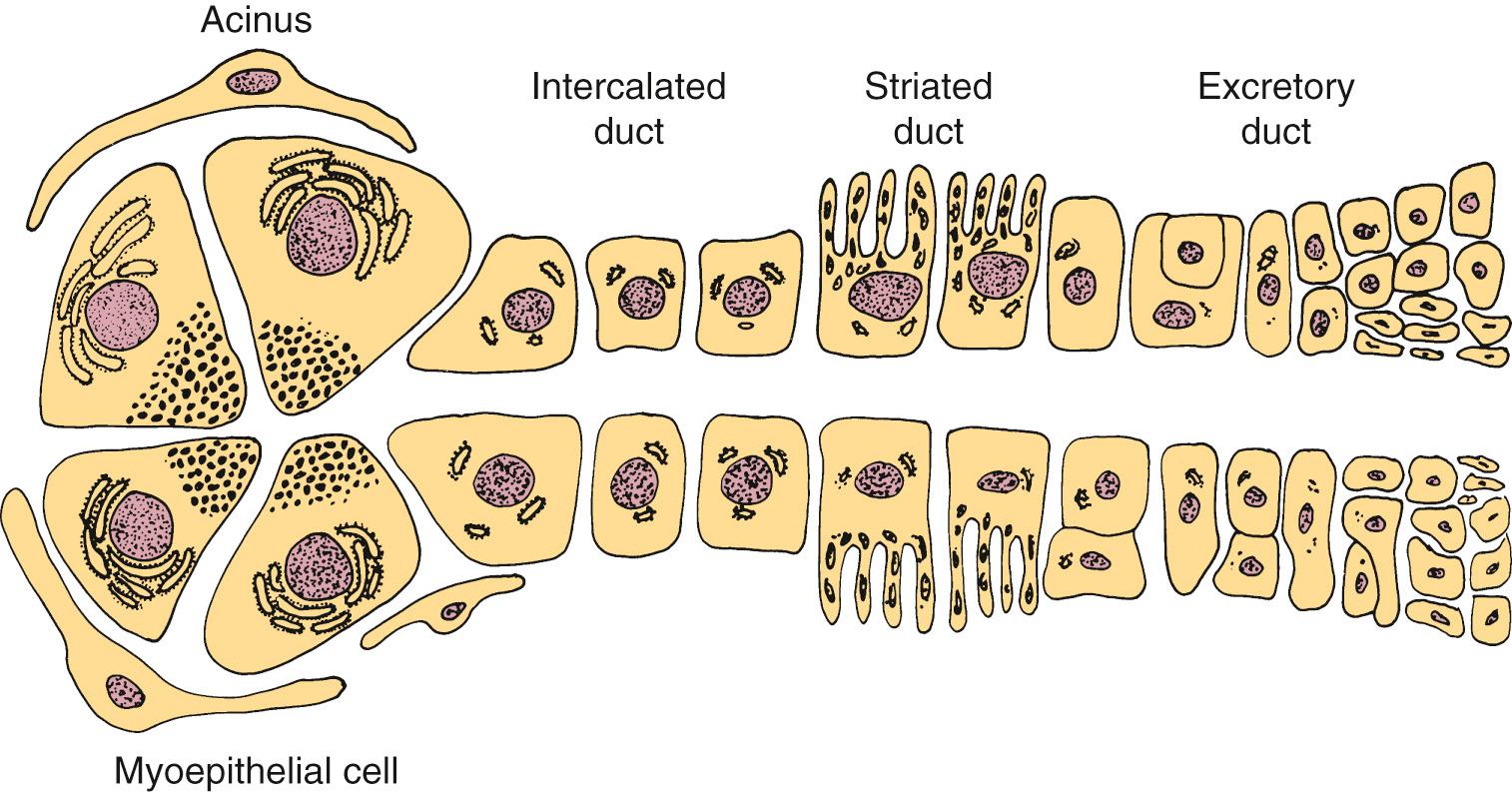
At least two theories of tumorigenesis have been proposed for salivary gland neoplasms. The bicellular stem cell theory (reserve cell theory) is currently the more commonly accepted theory. It states that neoplasms arise from two populations of undifferentiated stem cells: the excretory duct reserve cell or the intercalated duct reserve cell. According to this theory, both cell types can act as a stem cell with the potential to further differentiate into a variety of epithelial cell types. Histology of the neoplasm depends on the type of originating reserve cell and stage of differentiation at the time of neoplastic transformation. The second and less accepted theory is the multicellular theory , which proposes that differentiated cells are capable of cell division. This theory states that each type of salivary neoplasm originates from a distinctive differentiated cell type within the salivary gland unit. For example, Warthin and oncocytic tumors are thought to arise from striated ductal cells and mixed tumors from intercalated duct and myoepithelial cells.
The etiology of salivary gland neoplasms remains unknown. However, genomic alterations and environmental factors have been suggested to play a role as discussed in the following text.
Gene fusions and chromosomal arrangements define a subset of salivary neoplasms. Cytogenetic analysis of more than 400 pleomorphic adenomas has demonstrated that over 50% of cases harbored translocations involving chromosome 8q12. The target gene of 8q12 translocations is the pleomorphic adenoma gene 1 (PLAG1) , which becomes activated by the chromosomal rearrangements. PLAG1 -driven tumors are characterized by upregulation of insulin-like growth factor (IGF) and WNT signaling pathways. Additional rearrangements have also been identified in chromosome 12q14-15, involving the high-mobility group AT-hook2 gene (HMGA2) , which functions as a transcription regulator. The 12q14-15 translocations have been found in approximately 15% of pleomorphic adenomas. Both pleomorphic adenomas and carcinoma ex-pleomorphic adenomas harbor PLAG1 and HMGA2 fusions. As such, these genomic alterations cannot be used to exclude malignancy. However, high-grade tumors tend to demonstrate more genomic instability and subtype-specific alterations such as HER2 amplification in salivary duct carcinoma. Additional genomic alterations observed in benign salivary gland neoplasms include CTTNB1 mutation and 16q12-13 deletion in basal cell adenomas. Basal cell adenomas can rarely be associated with hereditary syndromes, namely the Brooke-Spiegler syndrome, an autosomal dominant disease characterized by the development of multiple adnexal cutaneous neoplasms.
Increasing evidence suggests that exposure to ionizing radiation may increase the risk of developing tumors of the salivary glands. In 1996, the Radiation Epidemiology Branch of the National Cancer Institute published a study on the risk of developing salivary gland tumors among atomic bomb survivors. The study indicated a higher radiation-related risk of developing both benign and malignant salivary gland tumors compared with the general population. Dose-response analyses found statistically significant increases in risk for both cancer and benign tumors with increasing radiation “dose” from the bomb. The risk was higher for malignant tumors, especially mucoepidermoid carcinoma. Among those with benign neoplasms, Warthin tumor showed the highest dose-response–related risk.
Radiation therapy to the head and neck, especially if it encompassed the salivary glands, may also be a risk factor in the development of salivary gland tumors. Modan and colleagues reported a 4.5-fold increase in the incidence of salivary gland cancer and a 2.6-fold increase of benign tumors among people exposed to low-dose scalp irradiation compared with matched controls. The mean length of latency period until tumor development was 11 years for malignant tumors and 21.5 years for benign growths.
Warthin tumor is strongly associated with cigarette smoking, and the risk decreases after smoking cessation. Recent studies have not demonstrated an association between Epstein-Barr virus and benign salivary neoplasms.
Most (70%) salivary gland tumors arise in the parotid gland ( Fig. 84.2 ). Although most minor salivary gland tumors are malignant, three-fourths of parotid tumors are benign ( Fig. 84.3 ). Spiro reviewed the Memorial Sloan Kettering experience with salivary neoplasms over a 35-year period. The distribution of these 2807 patients is shown in Table 84.2 . Benign neoplasms constituted 55% (1529 patients) of all the tumors in this study. Pleomorphic adenoma (1280 patients) constituted 84% of benign tumors and 45% of all salivary gland neoplasms. Warthin tumor was the second most common benign tumor and comprised 12% of all benign tumors (183 patients).
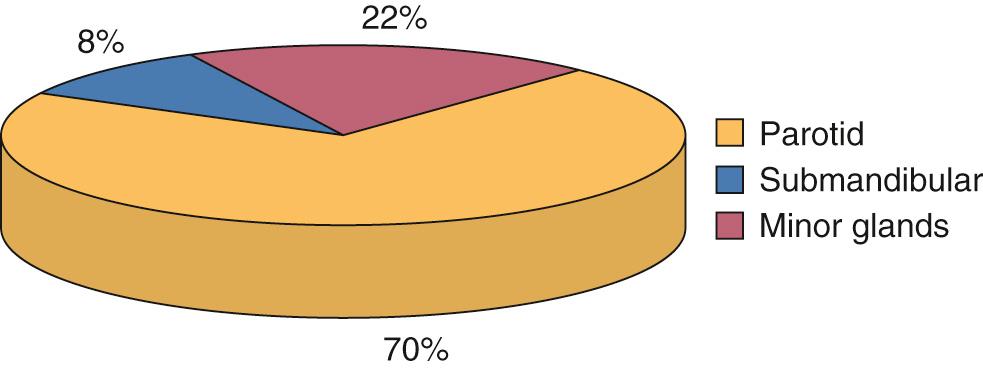
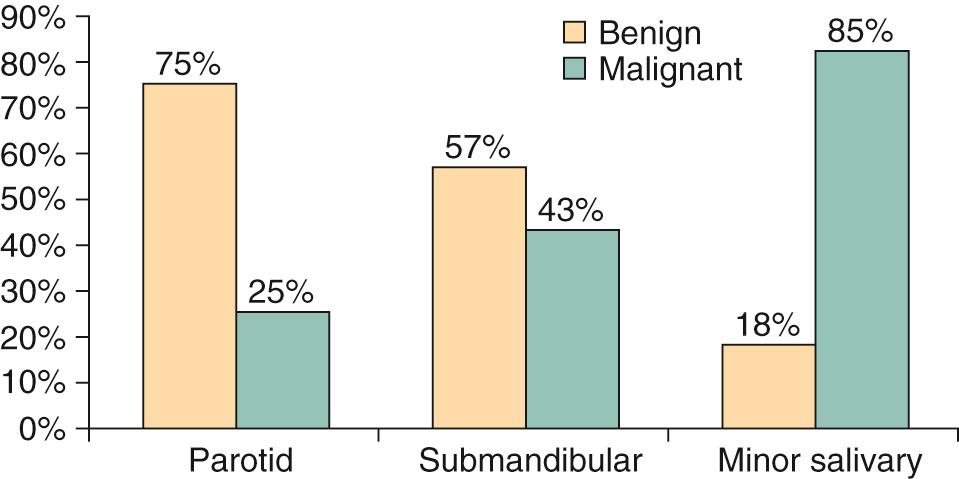
| Histology | No. of Patients | % |
|---|---|---|
| Pleomorphic adenoma | 1274 | 45.4 |
| Warthin tumor | 183 | 6.5 |
| Benign cyst | 29 | 1.0 |
| Lymphoepithelial lesion | 17 | 0.6 |
| Oncocytoma | 20 | 0.7 |
| Monomorphic adenoma | 6 | 0.2 |
| Mucoepidermoid carcinoma | 439 | 15.7 |
| Adenoid cystic carcinoma | 281 | 10.0 |
| Adenocarcinoma | 225 | 8.0 |
| Malignant mixed tumor | 161 | 5.7 |
| Acinic cell carcinoma | 84 | 3.0 |
| Epidermoid carcinoma | 53 | 1.9 |
| Other (anaplastic) | 35 | 1.3 |
| Total | 2807 | 100.0 |
Benign salivary gland tumors usually present as painless, slow-growing masses on the face for parotid tumors or at the angle of the jaw for submandibular tumors. Minor salivary gland tumors most commonly occur on the palatal mucosa but can also occur within other areas of the oral cavity, the parapharyngeal space, the paranasal sinuses, the nasal cavity, the larynx, or the lacrimal gland. Tumors may be found incidentally and most are asymptomatic. On exam, benign tumors are nontender, well-circumscribed, and mobile. Salivary gland tumors involving the parapharyngeal space, such as deep lobe parotid tumors ( Figs. 84.4 and 84.5 ), may present with unilateral aural fullness, dysphagia, obstructive sleep apnea, “hot potato” voice, and trismus. Exam may show a medially displaced oropharyngeal wall ( Fig. 84.6 ).
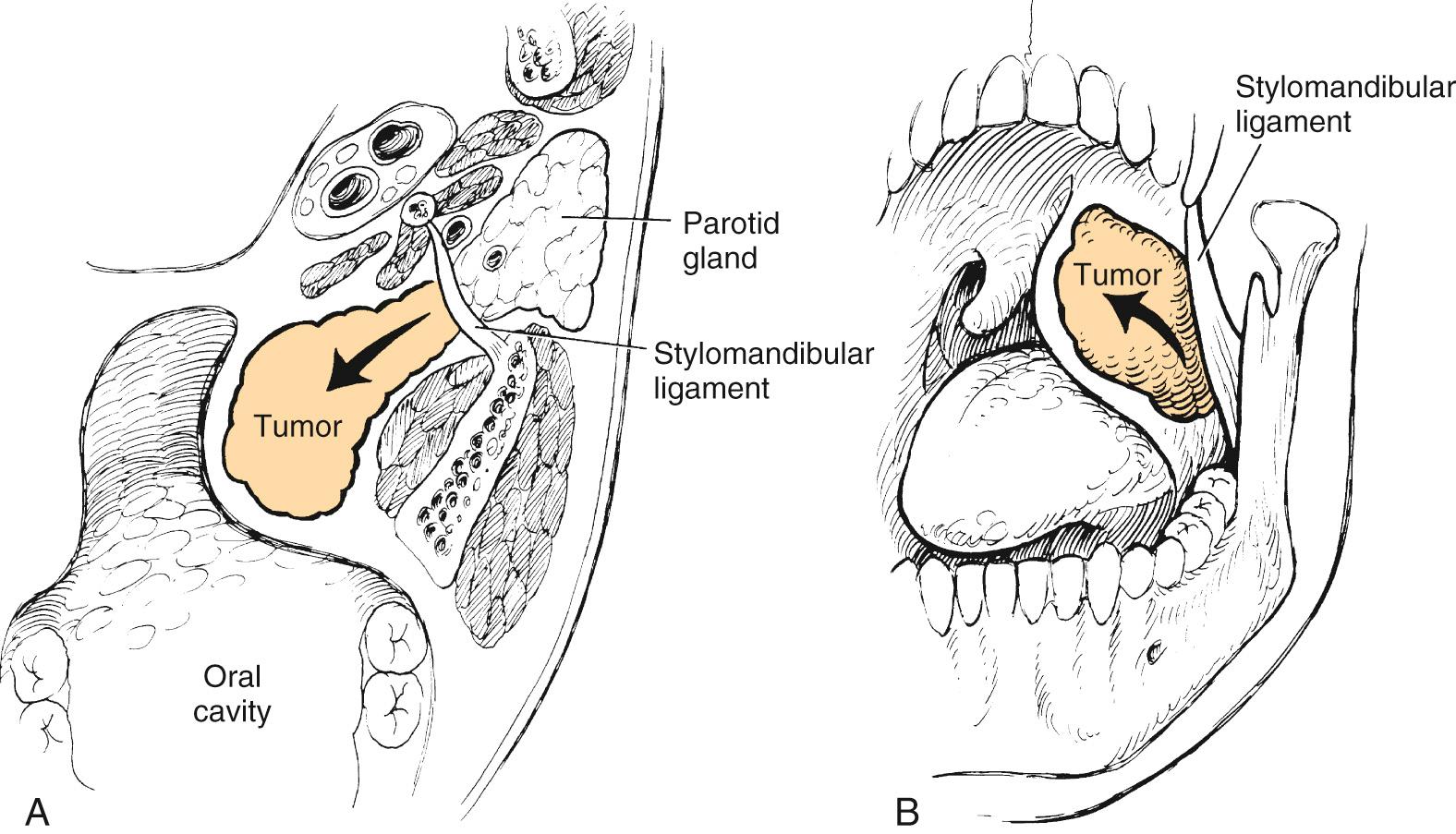
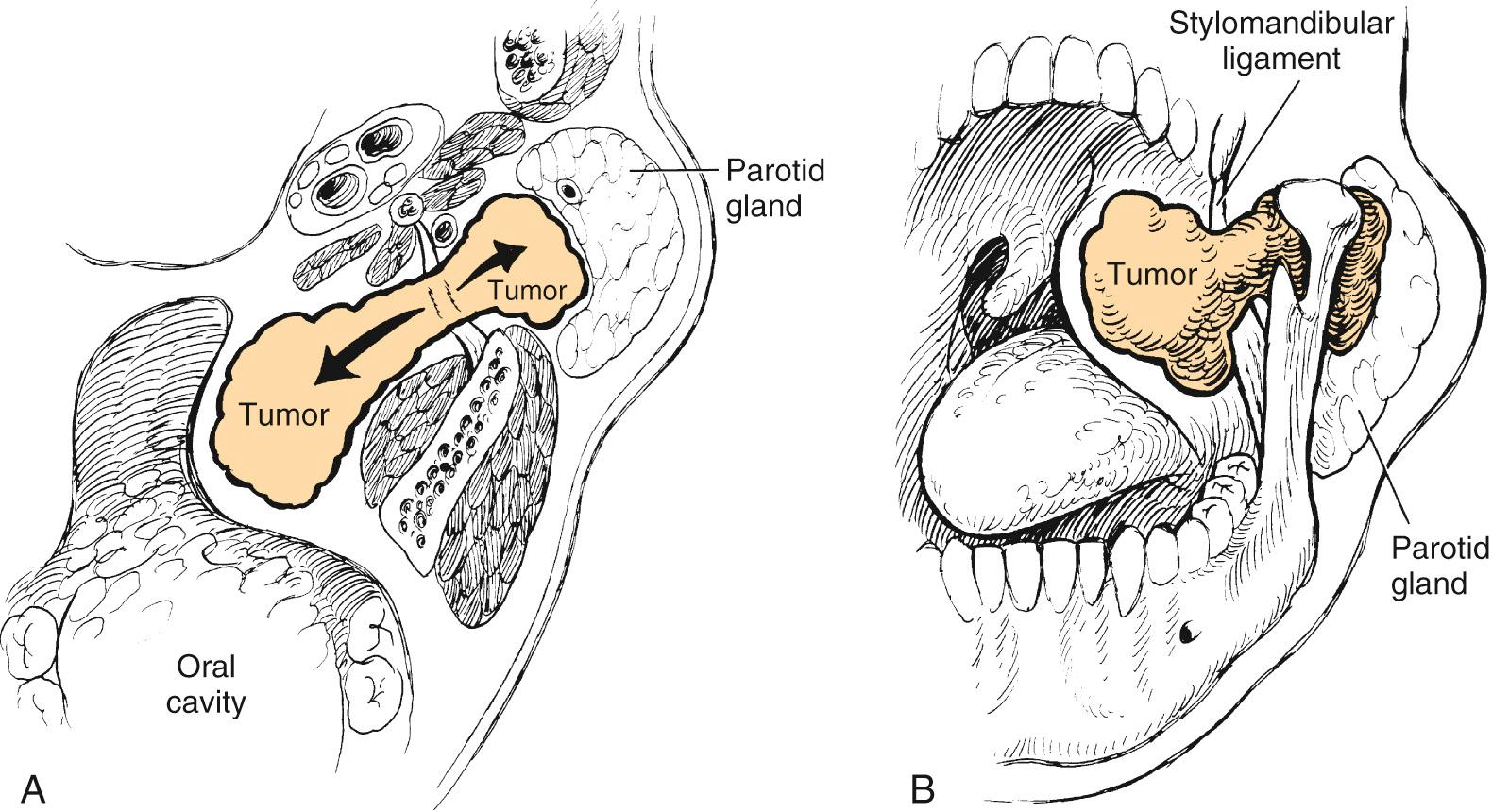
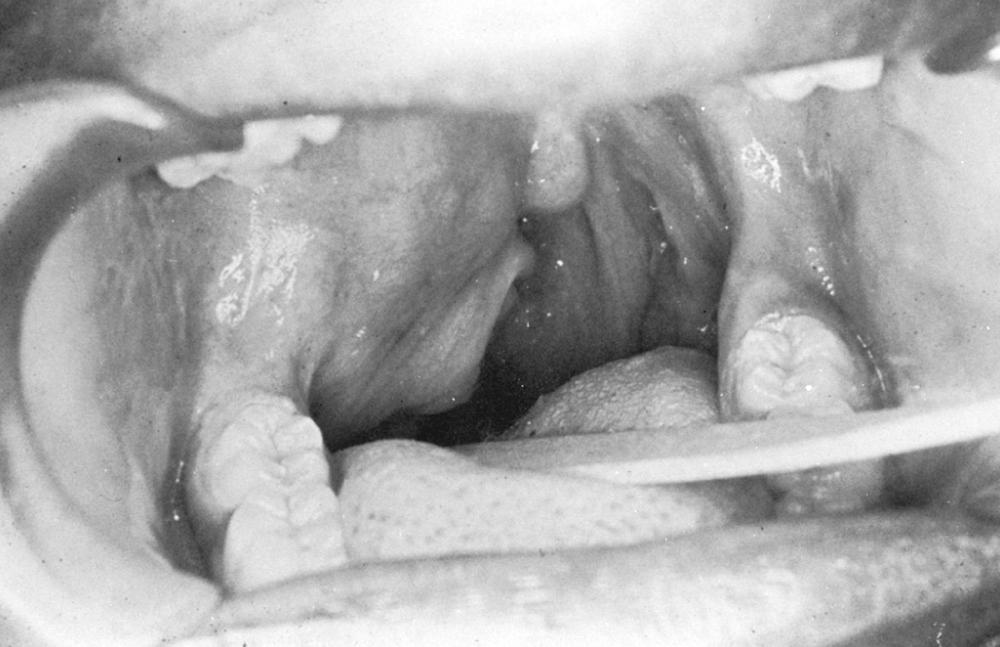
Rapid increase in the size of a long-standing mass should raise the suspicion for malignant transformation of a preexisting benign tumor but may also occur due to inflammation or cystic degeneration, most commonly associated with Warthin tumor. Facial nerve paralysis, pain, paresthesia, cervical lymphadenopathy, other cranial nerve deficits, and fixation to adjacent structures or overlying skin should also raise the suspicion for malignant transformation.
Fine-needle aspiration biopsy (FNAB) has been widely recognized and well established as a diagnostic tool in salivary gland neoplasms. Numerous studies have reported high sensitivity, specificity, and positive predictive value for FNAB. The overall sensitivity ranges from 85.5% to 99%, and the overall specificity ranges from 96.3% to 100%. In general, diagnostic accuracy is higher for benign salivary gland tumors. However, in up to 5% of samples, a malignant neoplasm can yield a cytologic diagnosis of benign neoplasm, demonstrating that false-negative results do occur. The accuracy of FNAB depends greatly on the experience of the cytopathologist and the overall volume of salivary neoplasms evaluated at a particular institution. The most common source of diagnostic error of FNAB is inadequate sampling, which occurs at a rate of approximately 5%. When initial FNAB is nondiagnostic, Brennan and colleagues have shown that repeat FNAB can have a high success rate (82%) in eventually providing a diagnosis. The use of ultrasound-guided FNAB may be of help when it is difficult to obtain a representative sample, and it enhances the overall diagnostic accuracy of the technique.
Given its histologic diversity, challenges exist in the cytopathologic diagnosis of salivary gland neoplasms. One contributing factor was the lack of a uniform reporting system to guide clinical management. Recently, an international panel of experts in salivary gland cytology, the American Society of Cytopathology, and the International Academy of Cytology jointly proposed an evidence-based reporting system known as the Milan System for Reporting Salivary Gland Pathology. The goal of the new classification system was to facilitate standardized reporting and improve the overall effectiveness of FNAB across institutions. Six categories were defined and shown in Table 84.3 . Their respective associated risks of malignancy are also shown in Table 84.3 . The “nonneoplastic” category includes specimens lacking evidence of a neoplastic process such as those demonstrating inflammatory, metaplastic, and reactive processes. In this category, clinicoradiologic correlation is essential to ensure that the specimen is representative of the lesion of interest. “Atypia of Undetermined Significance (AUS)” is a heterogeneous category where a neoplasm cannot be excluded. It may include lesions with reactive atypia or poorly sampled neoplasms and likely requires repeat FNA or surgery for definitive diagnosis. The “Benign Neoplasm” category is reserved for clear-cut benign neoplasms and has a low associated risk of malignancy of less than 5%. The “Salivary Gland Neoplasm of Uncertain Malignant Potential (SUMP)” category was developed for cases in which a neoplasm can be seen but a diagnosis of a specific entity cannot be made and a malignant neoplasm cannot be excluded. This category has an estimated risk of malignancy of 35%.
| Diagnostic Category | Risk of Malignancy | Management |
|---|---|---|
|
25% | Clinical and radiologic correlation or repeat fine-needle aspiration (FNA) |
|
10% | Clinical follow-up and radiologic correlation |
|
10%–35% | Repeat FNA or surgery |
|
Surgery or clinical follow-up | |
|
<5% | |
|
35% | |
|
60% | Surgery |
|
90% | Surgery |
Several specific issues can lead to diagnostic dilemmas. The most frequent problems involve variations in the expected cytology of pleomorphic adenoma. Also, there are several benign-malignant “look-alike” pairs of lesions. The first of these is related to small cell epithelial neoplasms of low nuclear grade; the most frequent problem is between basal cell adenomas and adenoid cystic carcinoma, particularly the solid type. The next area contrasts mucoepidermoid carcinoma with its cytologic mimic, benign salivary gland duct obstruction. The final difficulty in salivary gland aspiration contrasts large-cell epithelial lesions of low nuclear grade: oncocytic proliferations and acinic cell carcinoma.
FNAB is safe, simple to perform, and relatively inexpensive. Heller and colleagues performed a study to determine the impact of FNAB on patient management and found that FNAB resulted in a change in the clinical approach in 35% of the patients. Examples of such changes in the planned management included avoiding surgical resection for lymphomas and inflammatory masses and adopting a more conservative approach with benign tumors in elderly and high-risk surgical patients. FNAB also allows for better preoperative counseling of patients regarding the nature of the tumor, the likely extent of resection, management of the facial nerve, and the likelihood of a neck dissection. Such information is not only important in treatment planning but also helps alleviate an already high level of anxiety in patients and their families. In a similar study, Sharma and associates also demonstrated the impact FNAB had in altering the clinical decision making, which obviated the need for surgery in 40% of cases.
The possibility of tumor seeding is a commonly cited argument against the routine use of FNAB in patients with salivary gland tumors. To address these issues, Mukunyadzi and colleagues reviewed 94 resected salivary gland masses for infarction, hemorrhage, needle-tract tumor seeding, and fibrosis after FNAB. They concluded that FNAB with a 25-gauge needle is safe and does not significantly alter the histologic diagnosis, because tissue effects did not preclude accurate diagnostic interpretation in any case.
The routine use of imaging in patients with small, well-defined masses of the superficial lobe of the parotid gland remains controversial. However, tumors that present with clinical findings suggestive of malignancy, those that arise from the deep lobe of the parotid gland or the parapharyngeal space, and tumors of the submandibular and minor salivary glands should be evaluated with high-resolution imaging. In such cases, imaging provides accurate delineation of the location and extent of the tumor, its relation to major neurovascular structures, perineural spread, skull base invasion, and intracranial extension.
Become a Clinical Tree membership for Full access and enjoy Unlimited articles
If you are a member. Log in here